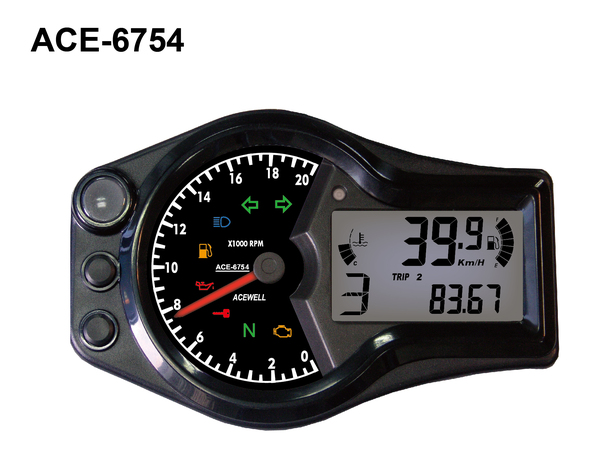Comprehensive Overview to Understanding and Using a Tachometer Successfully
Comprehensive Overview to Understanding and Using a Tachometer Successfully
Blog Article
The Significance of a Tachometer in Checking Engine Speed and Performance in Automotive Applications
In the realm of vehicle design, the tachometer stands as a pivotal instrument in the motorist's toolbox, offering a straight home window right into the inner workings of a vehicle's engine. Past its feature as a mere scale of changes per minute (RPM), the tachometer serves as a critical device for enthusiasts and professionals alike, providing real-time insights into engine performance and health and wellness.
Significance of Checking Engine RPM
Keeping track of engine RPM, or revolutions per min, is an important aspect of auto maintenance and performance examination. Engine RPM directly associates with the speed at which the engine's crankshaft rotates, indicating exactly how rapidly the engine is running.
In addition, keeping track of engine RPM is crucial for performance examination in auto racing and high-performance cars. In recap, keeping track of engine RPM is not just essential for spotting problems yet also for optimizing engine efficiency in various automobile applications.

Advantages of Real-Time Information
In auto applications, real-time data plays an essential function in giving immediate understandings right into the efficiency and problem of the lorry. By continuously keeping track of different specifications such as engine rate, temperature level, gas usage, and extra, real-time information offers numerous advantages that add to boosted effectiveness and safety on the roadway.
One significant advantage of real-time information is its capacity to sharp motorists and professionals to any kind of abnormalities or concerns promptly. This aggressive strategy makes it possible for fast recognition of prospective issues, enabling timely treatments to stop more damages or break downs. Furthermore, real-time data helps with performance optimization by offering immediate responses on driving routines and engine effectiveness. Drivers can readjust their actions in real-time based upon this info to achieve far better fuel economic climate and prolong the lifespan of their lorry.

Additionally, real-time information plays a crucial role in contemporary automotive diagnostics, making it possible for service technicians to rapidly diagnose and attend to malfunctions. This causes reduced downtime, lower upkeep prices, and ultimately, enhanced total car integrity and longevity (tachometer). By using the power of real-time data, automobile stakeholders can make informed decisions that favorably influence both the performance and durability of the lorry
Effect On Equipment Shifts
Reliable gear shifts in auto applications substantially affect total performance and driving experience. The tachometer plays a critical role in enhancing equipment shifts by offering real-time engine speed information to the vehicle driver. When coming close to the redline on the tachometer, it signals the chauffeur to upshift to protect against over-revving the engine and causing prospective damage. On the various other hand, downshifting at the ideal minute can aid keep the engine in its power band, ensuring responsive acceleration when required.
Moreover, the tachometer help in attaining smoother equipment changes, especially in hand-operated transmissions. By keeping an eye on engine rate, motorists can perform gear shifts at the optimum useful site RPM array, official source minimizing snagging movements and reducing wear on the transmission components. This accuracy on duty modifications not only enhances driving comfort but also adds to sustain efficiency.
Enhancing Gas Performance
Provided the important function the tachometer plays in enhancing gear changes for performance and engine health, it straight adds to maximizing gas performance in auto applications. By supplying real-time feedback on engine rate, the tachometer helps drivers in keeping the most reliable RPM variety for fuel economic situation. When motorists consistently check the tachometer and change their motoring practices accordingly, they can avoid unneeded fuel usage brought on by over-revving or hauling the engine.
Furthermore, the tachometer aids drivers identify the most fuel-efficient gear to be in at any type of given minute, preventing the engine from working more challenging than needed. In verdict, the tachometer offers as a beneficial device in enhancing gas efficiency by advertising optimal driving habits and identifying areas for improvement in the vehicle's performance.

Optimizing Engine Long Life
The tachometer's duty in keeping track of engine rate and performance is instrumental like it in making sure the durability of automotive engines. Checking the tachometer allows vehicle drivers to stay within the advised RPM range for their automobile, stopping unnecessary pressure on the engine and extending its life expectancy.

Conclusion
Finally, the tachometer plays a vital role in checking engine speed and efficiency in auto applications. By supplying real-time data on RPM, it enables efficient equipment shifts, improved gas efficiency, and made the most of engine longevity. This device is necessary for preserving ideal engine performance and making certain the total capability of a lorry.
Report this page